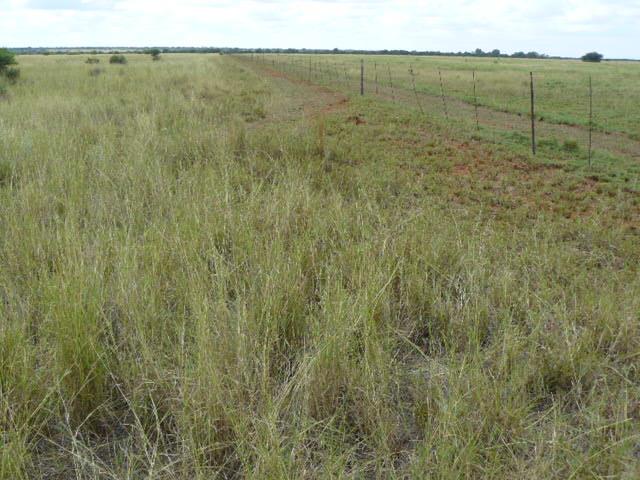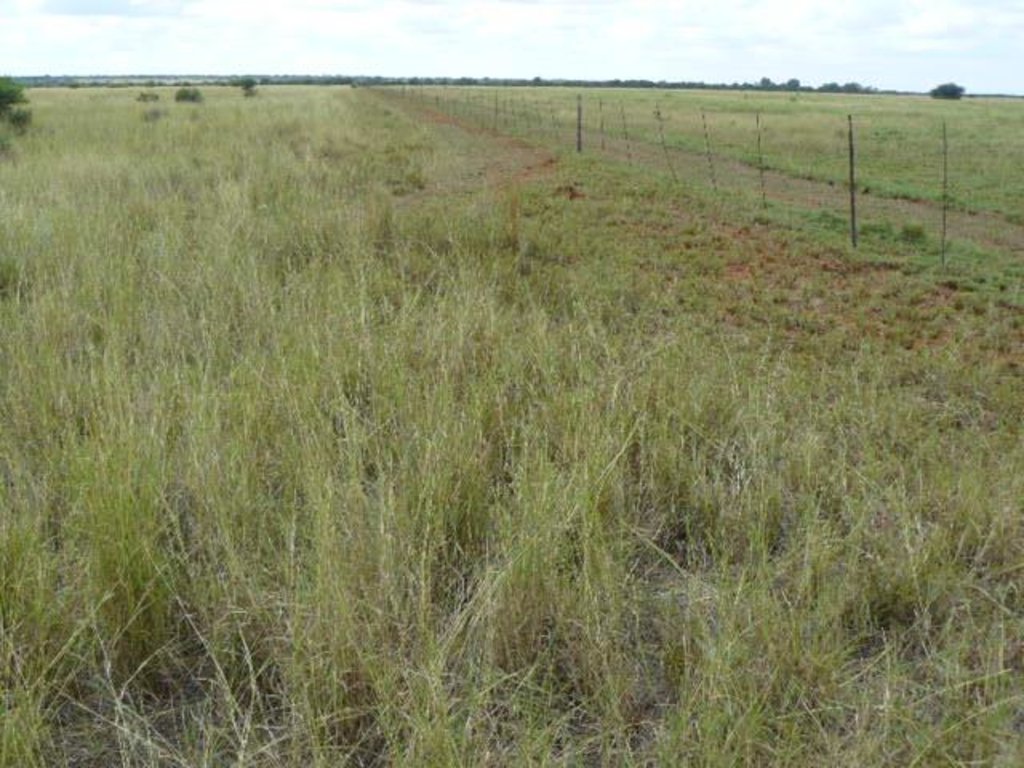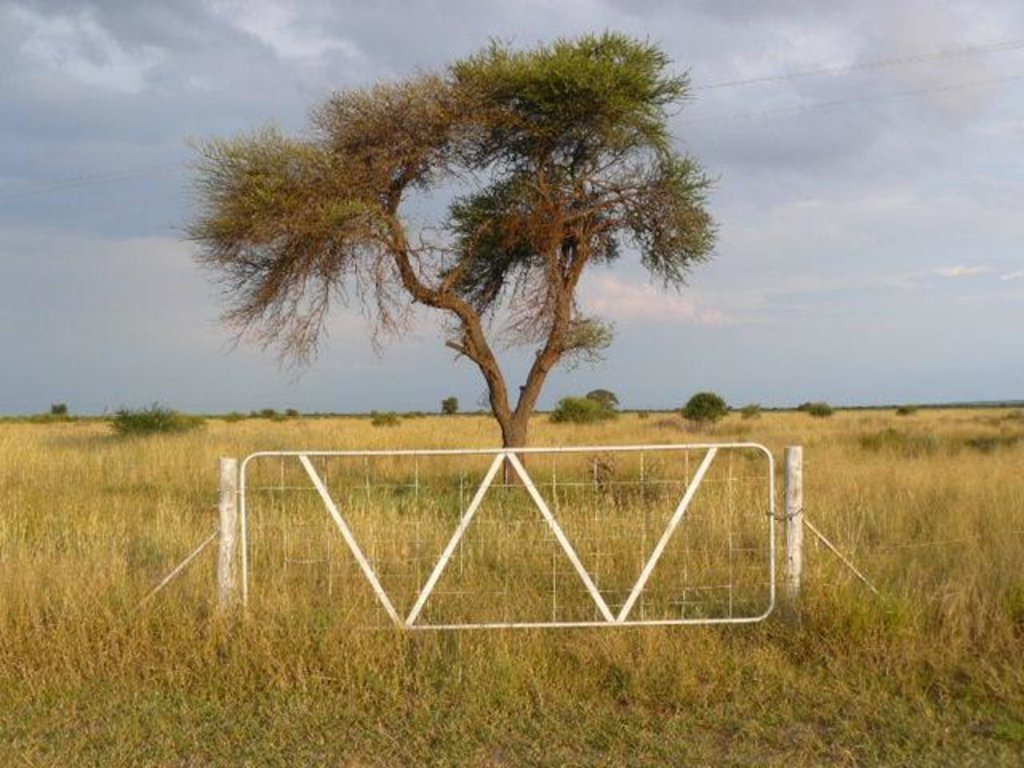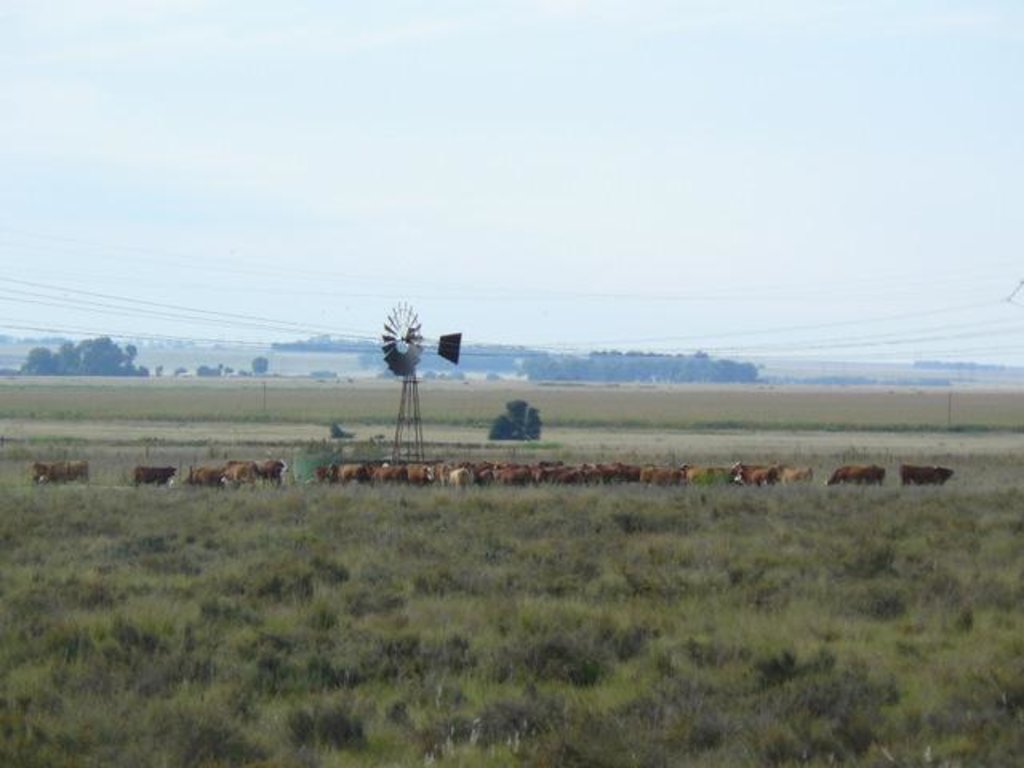Rotational Grazing [جنوب أفريقيا]
- تاريخ الإنشاء:
- تحديث:
- جامع المعلومات: Lehman Lindeque
- المحرر: –
- المراجعون: David Streiff, Alexandra Gavilano
technologies_1356 - جنوب أفريقيا
عرض الأقسام
توسيع الكل طي الكل1. معلومات عامة
1.2 تفاصيل الاتصال بالأشخاص الرئيسيين لمصدر المعلومات والمؤسسات المشاركة في تقييم وتوثيق التقنية
اسم المؤسسة (المؤسسات) التي سهلت توثيق/تقييم التقنية (إذا كان ذلك على صلة)
Ministry of Agriculture and Livestock Development of Kenya (MoA) - كينيا1.3 الشروط المتعلقة باستخدام البيانات الموثقة من خلال WOCAT
يوافق جامع المعلومات والشخص (لاشخاص) الرئيسي لمصدر المعلومات على الشروط المتعلقة باستخدام البيانات الموثقة من خلال WOCAT:
نعم
2. وصف تقنيةالإدارة المستدامي للأراضي
2.1 وصف مختصر للتقنية
تعريف التقنية:
Rotational grazing is a management system based on the subdivision of the grazing area into a number of enclosures and the successive grazing of these paddocks by animals in a rotation so that not all the veld (grazing area) is grazed simultaneously
2.2 وصف تفصيلي للتقنية
الوصف:
Consequently, rotational grazing allows higher stocking rates than continuous grazing. The main principles of rotational grazing are: (1) Control the frequency at which pasture is grazed: adjustment of the rotation cycle ensures a good forage quality in each paddock. Pasture plants (including the most preferred and therefore overused species) are provided with a period of recovery or rest following grazing; (2) Control the intensity at which the pasture plants are grazed by controlling the number of animals which graze each paddock and their period of occupation; (3) Reduce the extent of selective grazing by confining a relatively large number of animals to a small portion of the veld: little opportunity for selection prevents domination of undesirable species. Intensity of grazing should be adapted to the climatic conditions: in drier areas recovery periods should be longer due to limited plant recovery potential and high sensitivity to misuse and degradation. The ratio between periods of occupation and absence determines the plant yield and vigour: the shorter the period of occupation in a paddock the greater will be the yield of the veld: a second ‘bite’ is avoided and consequently the recovery period is at least equal to the period of absence. However, the shorter the period of occupation and the longer the period of absence, the greater is the number of paddocks required in a rotational grazing system. Ideal resting periods vary with growth rate, and with the rate at which the veld loses its quality with maturity. Depending on the season, the climate and the use of irrigation, resting periods vary between 14 and 70 days, and even longer in the semi-arid grasslands (90–150 days). Appropriate stocking rates are assessed through 4 rating factors (defining the veld condition): species composition, basal cover, topography and soil erodibility
2.3 صور التقنية
2.5 البلد/المنطقة/المواقع التي تم تنفيذ التقنية فيها والتي يغطيها هذا التقييم
البلد:
جنوب أفريقيا
المنطقة/الولاية/المحافظة:
Springbokvlakte region, Limpopo Provinc
مزيد من التفاصيل حول الموقع:
Crecy area
حدد انتشار التقنية:
- منتشرة بالتساوي على مساحة
2.7 إدخال التقنية
حدد كيف تم إدخال التقنية:
- من خلال المشاريع/ التدخلات الخارجية
3. تصنيف تقنية الإدارة المستدامي للأراضي
3.1 الغرض الرئيسي ( الأغراض الرئيسية) للتقنية
- الحد من تدهور الأراضي ومنعه وعكسه
3.2 نوع (أنواع) استخدام الأراضي الحالية حيث يتم تطبيق التقنية

أراضي الرعي
الرعي الواسع النطاق:
- مربى ماشية محدد
التعليقات:
Major land use problems (land users’ perception): Mainly biological degradation: reduction of vegetation cover, decreasing vegetation diversity
Ranching: Yes
3.5 مجموعةالإدارة المستدامة للأراضي التي تنتمي إليها هذه التقنية
- الرعي وإدارة المراعي
3.6 التدابير التقنية في مجال إلادارة المستدامة للأراضي

التدابير الإدارية
- M2: تغيير في مستوى الإدارة/الكثافة
3.7 الأنواع الرئيسية من تدهور الأراضي التي تناولتها التقنية

التدهور البيولوجي
- (Bc): تناقص الغطاء النباتي
- (Bq): انخفاض الكمية/الكتلة الحيوية
- (Bs): انخفاض جودة وتركيبة الأنواع/التنوع
3.8 منع أو حد أو عكس تدهور الأراضي
تحديد هدف التقنية فيما يتعلق بتدهور الأراضي:
- منع تدهور الأراضي
التعليقات:
Secondary goals: mitigation / reduction of land degradation, rehabilitation / reclamation of denuded land
4. المواصفات الفنية، وأنشطة التنفيذ، والمدخلات، والتكاليف
4.1 الرسم الفني للتقنية
المواصفات الفنية (المتعلقة بالرسم الفني):
Technical knowledge required for field staff / advisors: high (layout of the camps and design of stock watering and grazing system)
Technical knowledge required for land users: moderate (implementation of the system, building of fences and stock watering system, maintenance)
Main technical functions: improvement of ground cover, improvement of topsoil structure (compaction), increase of biomass (quantity), promotion of vegetation species and varieties (quality, eg palatable fodder)
Change of land use practices / intensity level: change of grazing management
4.3 أنشطة التأسيس
| النشاط | التوقيت (الموسم) | |
|---|---|---|
| 1. | Farm planning: including technical design of farm plan with grazing paddocks, rotational system and livestock watering system conducted mostly by extension workers or specialists from Dept. of Agriculture | |
| 2. | Fencing | |
| 3. | Establishment of stock watering system including the construction of a dam, windmill, drinking trough, pipeline and borehole | |
| 4. | Establishment of stock watering system including the construction of a dam, windmill, drinking trough, pipeline and borehole |
4.4 التكاليف والمدخلات اللازمة للتأسيس
| تحديد المدخلات | الوحدة | الكمية | التكاليف لكل وحدة | إجمالي التكاليف لكل مدخل | % من التكاليف التي يتحملها مستخدمو الأراضي | |
|---|---|---|---|---|---|---|
| العمالة | Farm planning, fencing, stock watering | persons/day/ha | 85,0 | 71,52 | 6079,2 | 100,0 |
| معدات | Equipment | area | 1,0 | 1160,0 | 1160,0 | 100,0 |
| مواد البناء | Construction material | area | 1,0 | 45173,0 | 45173,0 | |
| إجمالي تكاليف إنشاء التقنية | 52412,2 | |||||
| إجمالي تكاليف إنشاء التقنية بالدولار الأمريكي | 52412,2 | |||||
التعليقات:
Duration of establishment phase: 6 month(s)
4.5 الصيانة/الأنشطة المتكررة
| النشاط | التوقيت/الوتيرة | |
|---|---|---|
| 1. | Fencing | |
| 2. | Maintenance of windmill, pipeline, dam and drinking trough | |
| 3. | Implementing the system (moving livestock from one paddock to another, attend to livestock watering requirements (opening and closing of valves and attending to windmill brake on windy days) |
4.6 التكاليف والمدخلات اللازمة للصيانة/للأنشطة المتكررة (سنويًا)
| تحديد المدخلات | الوحدة | الكمية | التكاليف لكل وحدة | إجمالي التكاليف لكل مدخل | % من التكاليف التي يتحملها مستخدمو الأراضي | |
|---|---|---|---|---|---|---|
| العمالة | Fencing | persons/day/ha | 32,0 | 99,15 | 3172,8 | 100,0 |
| مواد البناء | Material | area | 1,0 | 10213,0 | 10213,0 | 100,0 |
| إجمالي تكاليف صيانة التقنية | 13385,8 | |||||
| إجمالي تكاليف صيانة التقنية بالدولار الأمريكي | 13385,8 | |||||
التعليقات:
Above mentioned costs are merely and indication for a typical livestock farm of 500 ha.
4.7 أهم العوامل المؤثرة على التكاليف
قدم وصفا لأهم العوامل التي تؤثر على التكاليف:
Estimated establishment time for a 500 ha farm with 8 paddocks more or less 6 month(s). The establishment and maintenance costs depend on farm size and the details of the farm plan/ design of the paddock system including variables such as number of paddocks, number of stock watering points, number of boreholes, etc.
5. البيئة الطبيعية والبشرية
5.1 المناخ
هطول الأمطار السنوي
- < 250 مم
- 251- 500 ملم
- 501 - 750ملم
- 1,000-751 ملم
- 1,500-1,100 ملم
- 2,000-1,500 ملم
- 3,000-2,001 ملم
- 4,000-3,100 ملم
- > 4000 ملم
المواصفات/التعليقات على هطول الأمطار:
Also 501-750 mm
المنطقة المناخية الزراعية
- شبه رطبة
- شبه قاحلة
Thermal climate class: subtropics
5.2 طوبوغرافيا
متوسط الانحدارات:
- مسطح (0-2%)
- بسيط (3-5%)
- معتدل (6-10%)
- متدحرج (11-15%)
- تلال (16-30%)
- شديدة الانحدار(31-60%)
- فائقة الانحدار (>60%)
التضاريس:
- هضاب/سهول
- أثلام مرتفعة
- المنحدرات الجبلية
- منحدرات التلال
- منحدرات في السفوح
- قاع الوادي
المنطقة الارتفاعية:
- 100-0 متر فوق سطح البحر
- 500-101 متر فوق سطح البحر
- 1,000-501 متر فوق سطح البحر
- 1,500-1,001 متر فوق سطح البحر
- 2,000-1,501 متر فوق سطح البحر
- 2,500-2,100 متر فوق سطح البحر
- 3,000-2,501 متر فوق سطح البحر
- 4,000-3,001 متر فوق سطح البحر
- > 4000 متر فوق سطح البحر
التعليقات والمواصفات الإضافية بشأن التضاريس:
Slopes on average: Also moderate (6-10%)
5.3 التربة
متوسط عمق التربة:
- ضحل جدًا (0-20 سم)
- ضحلة (21-50 سم)
- متوسطة العمق (51-80 سم)
- عميقة (81-120 سم)
- عميقة جدًا (> 120 سم)
المواد العضوية في التربة السطحية:
- متوسطة (1-3%)
إذا كان متاحًا، قم بإرفاق وصف كامل للتربة أو تحديد المعلومات المتوفرة، على سبيل المثال نوع التربة، الرقم الهيدروجيني/ درجة حموضة التربة، قدرة التبادل الكاتيوني، النيتروجين، الملوحة وما إلى ذلك.
Soil fertility is high and just soils with high fertility are used for cultivation
Soil drainage / infiltration is medium - good
5.6 خصائص مستخدمي الأراضي الذين يطبقون التقنية
التوجه السوقي لنظام الإنتاج:
- تجاري/سوق
أفراداً أو مجموعات:
- فرد/أسرة معيشية
مستوى المكننة:
- ميكانيكية/ مزودة بمحرك
اذكر الخصائص الأخرى ذات الصلة لمستخدمي الأراضي:
Difference in the involvement of women and men: mainly large-scale commercial livestock farmers (large areas allow for many grazing paddocks)
Population density: 100-200 persons/km2
5.7 متوسط مساحة الأرض التي يستخدمها مستخدمو الأراضي الذين يطبقون التقنية
- < 0.5 هكتارا
- 0.5 - 1 هكتار
- 1 -2 هكتار
- 2 - 5 هكتار
- 5 - 15 هكتار
- 15 - 50 هكتار
- 50 - 100هكتار
- 500-100 هكتار
- 1,000-500 هكتار
- 10,000-1,000 هكتار
- > 10,000 هكتار
هل يعتبر هذا نطاقًا صغيرًا أو متوسطًا أو واسعا (في إشارة إلى السياق المحلي)؟:
- على نطاق واسع
5.8 ملكية الأراضي، وحقوق استخدام الأراضي، وحقوق استخدام المياه
ملكية الارض:
- مجتمعي/قروي
- فردية، لا يوجد سند ملكية
حقوق استخدام الأراضي:
- مجتمعي (منظم)
- فردي
التعليقات:
Mainly individual not titled or partly communal village ownership
6. الآثار والتصريحات الختامية
6.1 الآثار التي أظهرتها التقنية في الموقع
الآثار الاجتماعية والاقتصادية
الإنتاج
إنتاج الأعلاف
التعليقات/ حدد:
In available dry-material
إنتاج حيواني
التعليقات/ حدد:
Due to increased and better fodder
خطر فشل الإنتاج
منطقة الإنتاج
التعليقات/ حدد:
Due to better drinking water availability
توافر المياه ونوعيتها
توافر مياه الشرب
التعليقات/ حدد:
Through improved livestock watering systems
نوعية مياه الشرب
التعليقات/ حدد:
Through improved livestock watering systems
الدخل والتكاليف
دخل المزرعة
الآثار الاجتماعية والثقافية
الأمن الغذائي / الاكتفاء الذاتي
الآثار الايكولوجية
دورة المياه / الجريان السطحي
الجريان السطحي
التبخر
التربة
رطوبة التربة
غطاء التربة
التنوع البيولوجي: الغطاء النباتي، الحيوانات
الكتلة الحيوية/ طبقة الكربون فوق التربة
التنوع النباتي
تنوع الموائل
الحد من مخاطر المناخ والكوارث
آثار الجفاف
6.2 الآثار التي أظهرتها التقنية خارج الموقع
توافر المياه
تلوث المياه الجوفية/الأنهار
6.3 تعرض التقنية وحساسيتها لتغير المناخ التدريجي والظواهر المتطرفة/الكوارث المرتبطة بالمناخ (كما يراها مستخدمو الأراضي)
التعليقات:
The technology is tolerant to climatic changes: land users can adjust grazing and resting periods according to changing conditions
6.4 تحليل التكلفة والعائد
كيف يمكن مقارنة العوائد نسبة لتكاليف الإنشاء (من وجهة نظر مستخدمي الأراضي)؟
عوائد قصيرة الأجل:
سلبي للغاية
عوائد طويلة الأجل:
إيجابي
كيف تتم مقارنة العوائدمع كلفة الصيانة/التكاليف المتكررة (من وجهة نظر مستخدمي الأراضي)؟
عوائد قصيرة الأجل:
سلبي قليلا
عوائد طويلة الأجل:
إيجابي
التعليقات:
Establishment costs are very high and discourage many farmers from using a multi-paddock grazing system
6.5 اعتماد التقنية
التعليقات:
There is a moderate trend towards spontaneous adoption of the Technology
Comments on adoption trend: Since 1994 rotational grazing has no longer been subsidised by the government (subsidies are restricted to small-scale communal and subsistence farmers). There is a moderate positive trend in adoption of the technology.
6.7 نقاط القوة / المزايا / الفرص التي توفرها التقنية
| نقاط القوة/ المزايا/ الفرص من وجهة نظر مستخدمي الأراضي |
|---|
| Rotational grazing allows higher stocking rates than continuous grazing |
| Adaptation to climate change and droughts |
6.8 نقاط ضعف / مساوىء / مخاطر التقنية وسبل التغلب عليها
| نقاط الضعف/ المساوىء/ المخاطر من وجهة نظر مستخدم الأراضي | كيف يمكن التغلب عليها؟ |
|---|---|
| Cost of construction or initial implementation | convince farmers to see it as a long term investment to ensure sustainable production |
| Veld fires damage fences and drinking troughs | prevent accidental veld fires by making fire bunds at the start of the dry season |
7. المراجع والروابط
7.2 المراجع للمنشورات المتاحة
العنوان، المؤلف، السنة، النظام القياسي الدولي لترقيم الكتب ISBN:
Tainton N.M. 1988. Veld and Pasture Management in South Africa. Shuter & Shooter, Pietermaritzburg in association with University of Natal Press, Pietermaritzburg
العنوان، المؤلف، السنة، النظام القياسي الدولي لترقيم الكتب ISBN:
Department of Agriculture and Water Supply. 1989. Veld management in the Eastern Cape. Government Printer, Pretoria
الروابط والوحدات المواضيعية
توسيع الكل طي الكلالروابط
لا يوجد روابط
الوحدات المواضيعية
لا يوجد وحدات مواضيعية





